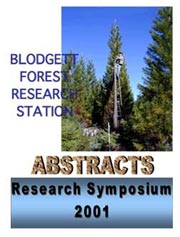 |
||||||||||||||
|
||||||||||||||
| 2001 Blodgett Forest Research Symposium |
| Research Projects | Research Publications | Back to TABLE OF CONTENTS |
|
|||||
Methylbutenol is a 5 carbon alcohol produced in the foliage of pines in the subsections ponderosae, contortae and oocarpae of the subgenus pinus. Production of methylbutenol is light dependent and closely follows the light response of photosynthesis; however these processes respond very differently to temperature. In response to increasing temperature photosynthesis declines whereas MBO emission increases almost exponentially following a pattern described by enzyme kinetics. Methylbutenol is of interest for two disparate reasons. First, it is photochemically reactive and can lead to the formation of tropospheric ozone when it reacts with the nitrogen oxides released in car exhaust. Second, its production represents a large expenditure of carbon by the plant for which there is no currently accepted function. On average MBO production costs ponderosa pine 0.5% of the carbon it fixes through photosynthesis, an amount tenfold higher than that allocated to the production of defensive monoterpenes. The goals of my research at Blodgett have likewise been twofold. I have attempted to develop a better understanding of the environmental parameters influencing rates of MBO emission into the atmosphere; and through these and other experiments I have attempted to test hypotheses about the biological function that MBO may play for the plant. In 1998 I began looking at the influence of ambient temperature, ambient light environment, needle age, and seasonal drought on the emission capacity of MBO. Despite the large effect that water stress had on photosynthetic rate, MBO emission capacity was not affected. Conversely ambient growth temperature had little effect on PS rate, but MBO emission capacity increased linearly with ambient temp. Altering the ambient light environment of ponderosa pine foliage using shade cloth affected neither photosynthesis nor MBO emission capacity. The emission capacity of needles was also found to decline with age. Given the high MBO production rates of ponderosa pine as well as the fact that the European bark beetle Ips typographus uses MBO as part of its aggregation pheromone, I conducted an experiment to test whether MBO acts as a defensive compound. Using Lindgren funnel traps baited with pheromone and vials releasing MBO at controlled rates, I compared the capture rates of Ips paraconfusus and Dendroctonus Brevicomis. Neither bark beetle species nor their predators responded to MBO. |
|||||
Contact Author: Dennis W. Gray, Department of Ecology and Evolution, State University of New York, Stony Brook, NY 111994-5245, (516) 632-7626, e-mail: denwgray@life.bio.sunysb.edu Dennis W. Gray and Manuel T. Lerdau Department of Ecology and Evolution, State University of New York, Stony Brook, NY 11994-5245 Allen H. Goldstein Department of Environmental Science, Policy, and Management (ESPM), University of , California at Berkeley, 151 Hilgard Hall, Berkeley CA, 94720 |
|||||
|
|||||
|
University of California Center for Forestry, UC Berkeley. Last modified: 6/27/02 ©Copyright, 2001. The Regents of the University of California. For questions and comments, contact webmaster. |
